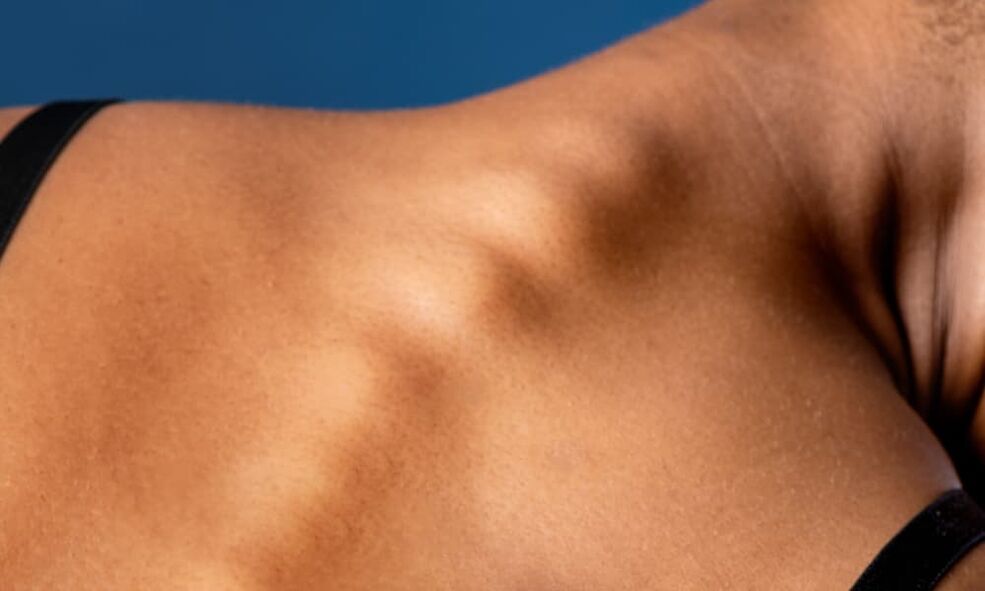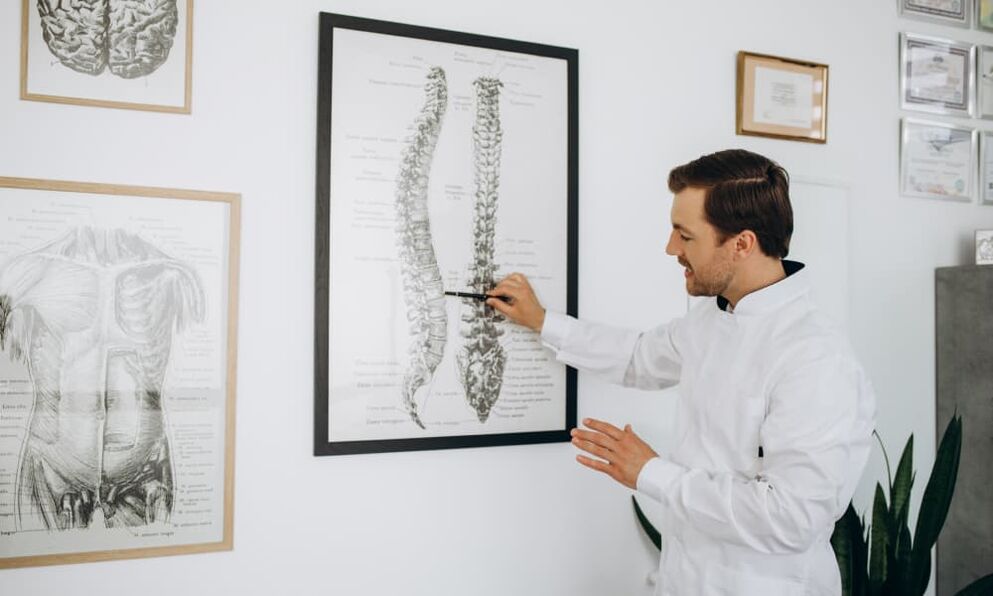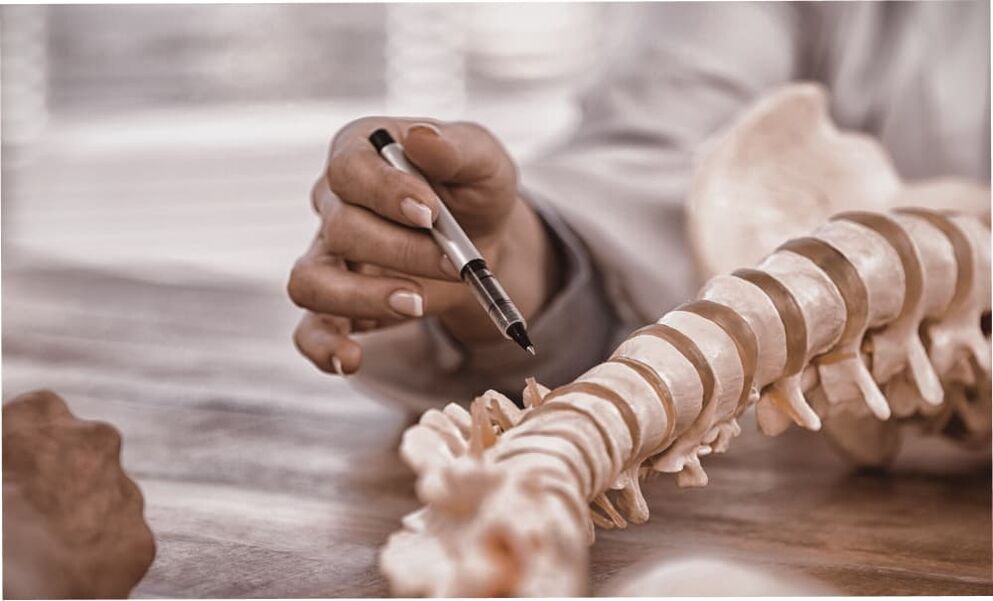
Osteochondrosis– a degenerative-dystrophic disease, which manifests itself in a decrease in the height of the hyaline intervertebral cartilages. Ultimately, this leads to disc wear and loss of functionality.
The disease is most often diagnosed in the age group of 30-35 years, it affects about 40% of the population under 35-40, and nearly 90% in the elderly. However, it may appear earlier in the presence of unfavorable factors.
Osteochondrosis of the spine is one of the main causes of back pain. Insufficient treatment can lead to damage to nerve roots, damage to the spinal cord and dysfunction of internal organs. Therefore, it is very important to consult a doctor immediately and take appropriate measures to prevent the development of the disease.
Causes of osteochondrosis

Osteochondrosis is a common disease that can also occur in the elderly, but it can also occur in young people who are used to a sedentary lifestyle. This disease develops due to the weakening of the back muscles, which leads to disruption of the blood flow and nutrition of the tissues of the spine and intervertebral discs. It can occur for a variety of reasons, including aging, injury, sudden stress, and improper work habits.
Although the causes of osteochondrosis are not fully understood, they are related to various factors, including:
- heredity,
- poor physical development,
- metabolic disease,
- unhealthy diet
- lack of vitamins and minerals,
- long-term medication use,
- overweight,
- increased load on the spine,
- a sedentary lifestyle, for example when working in an office,
- spinal injuries,
- previous infectious diseases and stress.
In addition, disorders of the nervous system and musculoskeletal system can contribute to the occurrence of osteochondrosis. In general, it can be said that the development of this disease is due to a combination of many factors, and its prevention consists of proper nutrition, moderate physical activity, proper distribution of spinal loads, and maintaining a healthy lifestyle in general.
Symptoms and signs of osteochondrosis
With the development of osteochondrosis in the first stage, patients often experience the following problems:
- Pain in different parts of the body, such as the back, neck or other areas;
- Movement difficulties and limitations when turning or bending;
- Constant tension and muscle spasms;
- Migraine and dizziness;
- Painful sensations in the area of the heart;
- Muscle hypotension, decreased muscle tone and strength;
- Numbness of the limbs;
- Pain in the arms and legs;
- seeing spots before the eyes;
- Cooling of the limbs;
- Recording painful feelings.
If osteochondrosis is advanced, serious complications may occur, such as:
- Black out;
- Decreased sensitivity of the limbs;
- Poor blood circulation in the vessels;
- Nerve damage or inflammation;
- Narrowing and blockage of arteries.
It is necessary to pay attention to the changes in the state of the body, and in case of suspicion of the development of osteochondrosis, a specialist should be sought for help. Seeking help early can prevent serious complications and improve quality of life.
Risk factors
Osteochondrosis can occur as a result of injury or heavy physical activity, which is especially common among athletes. It also manifests itself in the form of bone growth, osteophytes, protruding intervertebral discs and curvature of the spine. Congenital spine defects can also cause rapid wear of the intervertebral discs. In addition, the following risk factors can lead to the development of osteochondrosis:
- Neuro-emotional exhaustion;
- Physical overload of the body;
- Working on vibrating platforms;
- Genetic predisposition;
- lack of vitamins in the body;
- Multiple pregnancy.
Understanding these risk factors can help prevent the possibility of developing osteochondrosis. Managing your health with a healthy lifestyle and diet, and avoiding injury and overuse can reduce the likelihood of this problem occurring. If you suspect osteochondrosis, consult a doctor to quickly start treatment and prevent possible complications.
Classification and developmental stages of osteochondrosis
Classification of osteochondrosis
There are different forms of osteochondrosis, which can manifest as pain in different parts of the spine.
- Lumbodynia– this is lumbar (lumbosacral) back pain.
- Sciaticamanifests as back pain that spreads to the legs.
- Lumbago- this is a lumbar lumbago, with acute and severe pain in the lower back.
- Thoracalgia- It's a pain in the chest.
Another form of osteochondrosis, cervicalgia or cervicobrachialgia, causes pain in the neck and upper limbs.
In addition, the types of osteochondrosis can vary depending on which part of the spine is affected. Osteochondrosis of the cervical spine manifests itself in headaches and difficulty turning the head, osteochondrosis of the thoracic spine causes pain in the thoracic spine, and osteochondrosis of the lumbar spine can manifest itself in difficulty bending forward and sometimes "shooting" pain in the leg.
Stages of development of osteochondrosis
Osteochondrosis is one of the most common diseases of the spine. Its development goes through several stages.
- I.In the first stage, the core of the intervertebral disc loses moisture and becomes less elastic, which leads to a decrease in height and tearing of the tissues. At this stage, the pain is usually almost imperceptible, but discomfort may occur during physical activity or unusual posture.
- II.In the second stage of the development of osteochondrosis, the disc tissue begins to flatten and bulge, which leads to a narrowing of the space between the vertebrae and pinching of the spinal nerve roots. The fibrous membrane is destroyed, leading to poor fluid retention in the disc core. During movement, characteristic snaps and creaking sounds can be heard in the spine. At this stage, point pain appears, which increases with active movements.
- III.The third stage is characterized by wear and thinning of the linings between the discs. At this stage, the symptoms of osteochondrosis appear intensively in the form of acute pain. You need to take painkillers to treat neuralgia for quick pain relief.
- ARC.In the last, fourth stage, the destruction of the discs is so severe that the joints become inactive and the space between the vertebrae is filled with bone tissue. Severe dystrophic processes can cause acute pain, as growths damage adjacent tissues and compress nerves. A complete loss of mobility of the vertebral joints is possible.
Complications
Consider the various complications that arise during osteochondrosis:
- Disc protrusion, which occurs when the nucleus pulposus of the disc protrudes beyond the annulus fibrosus. This can lead to spinal pain and dysfunction.
- Intervertebral hernia- This is an even more serious complication when the disc ring ruptures and the nucleus pulposus extends beyond it. This can cause severe pain, reduced sensation and paralysis.
- Radiculitis- This is a pinched nerve root that causes severe pain. Radiculitis can lead to numbness, tingling, and weakness in the lower limbs.
- Kyphosisspinal deformity, which manifests as a bulge in the chest area. This can lead to breathing problems, pain and poor posture.
- Spinal cord stroke– this is the most serious complication of osteochondrosis, which can lead to loss of sensitivity, impairment of motor functions, and even paralysis.
- Muscular atrophy of the lower limbs- this is a decrease in muscle mass, which is accompanied by rapid fatigue and weakness of the legs.
- Leg paralysis– this is the complete loss of the ability to voluntarily move the lower limbs, which is a serious complication of osteochondrosis.
Methods of diagnosing osteochondrosis

Osteochondrosis is a pathology characterized by the degenerative process of the spinal structure. Based on clinical studies, we can learn more about the treatment of this pathology.
If osteochondrosis is suspected, the doctor performs a comprehensive diagnosis, including the following methods:
- Physical analysis.The doctor examines the patient and assesses his general condition, posture and movements. The doctor may also perform a neurological examination to determine the presence or absence of sensory and motor problems.
- Hardware scan.For a more accurate diagnosis, various hardware examination methods are used, including radiography, computed tomography (CT) and magnetic resonance imaging (MRI).
- Blood test.A complete blood count can help identify early signs of osteochondrosis, such as an elevated erythrocyte sedimentation rate and low calcium levels. To confirm the diagnosis, biochemical tests can be prescribed that evaluate blood coagulation parameters, enzyme activity, the content of zinc, cobalt, iron and other components.
- Radiography.During X-rays, each spine is checked and images are taken in direct, lateral and two oblique views. If necessary, functional radiography can be prescribed, which allows assessing the condition of the spine in different positions.
- Computed tomography (CT).CT is performed after radiography and allows for a more accurate determination of the condition of the intervertebral discs. For this, images are taken of one or two segments of the spine.
- Magnetic resonance imaging (MRI).MRI is used in addition to CT or in cases where it is necessary to study the condition of blood vessels, nerve processes and intervertebral discs in more detail.
When to see a doctor
In case of persistent back pain, muscle spasms and reduced sensitivity, a medical consultation is required.
Treatment of osteochondrosis

Osteochondrosis is a disease of the spine characterized by degenerative changes of the intervertebral discs. It can lead to back pain, neck pain, headaches and other unpleasant symptoms. Treatment of osteochondrosis can be a long and labor-intensive process, but modern methods can help relieve pain and improve quality of life. This can be conservative or surgical, depending on the rate of progression and severity of symptoms. In most cases, strengthening of the ligaments and muscles and the use of medication are recommended.
During the treatment of osteochondrosis, it is important to consider the individual characteristics of each patient. Some massage or manual therapy methods may be undesirable or even dangerous in a given case. Therefore, it is important to have an individual consultation before starting treatment.
Procedures and methods for treating osteochondrosis include physiotherapy, gymnastics (physical therapy), wearing an orthopedic pillow or corset, and taking muscle relaxants and non-steroidal pain relievers.
Movement therapy
Leading countries with good medical standards prefer to use exercise therapy. These are classical physical therapy, physical therapy exercises in water, swimming, simulator training and computer hardware complexes. The styles are selected by the doctor and may vary depending on the individual characteristics of each patient. Swimming can also be beneficial, but it requires proper technique to avoid health damage.
Treatment of osteochondrosis with manual therapy
Manual therapy can be used in the initial stage. This method helps to strengthen the muscle frame, eliminate blockages and pinched nerve roots. However, if the shape of the vertebrae changes and bone spurs form, this type of treatment is not recommended.
Correctly performed manual therapy can improve the configuration of the spine. Sometimes permanent functional blockages can appear, that is, stiff areas in the spine and sacrum that cannot be eliminated with therapeutic exercises.
Modern manual therapy is different from those used in the past. Most doctors no longer use hard techniques accompanied by crunching, but instead prefer soft techniques. These are based on knowledge of biomechanics, the functioning of joints, and the laws of muscle contraction and relaxation. With these methods, the risk of side effects is lower and the effectiveness has not changed.
Massage
Massage has many contraindications, so the neurologist must prescribe individual treatment. It is important to choose a knowledgeable massage therapist that the doctor works with. The massage must be performed regularly, usually the doctor prescribes at least 2-3 treatments per week for 1-3 months.
Correctly performed medical massage in osteochondrosis of the spine:
- It provides additional load to the muscles and increases their tone;
- Dispels lactic acid accumulation and relieves muscle spasms;
- Improves blood circulation in the affected area and adjacent tissues;
- It relieves pain.
Only medical massage is suitable for the treatment of osteochondrosis, while Thai massage is dangerous. Most Thai massage therapists use harsh manual therapy techniques and do not pay attention to the patient's physical condition.
Physiotherapy
Depending on the location and stage, patients may be prescribed the following types of physiotherapy:
- Magnetotherapythe effect of a constant frequency magnetic field that stimulates a cellular response.
- Electrophoresis for osteochondrosis– this is the effect of the electric field on tissues, which accelerates blood circulation and activates regeneration processes.
- Laser therapya method that stimulates the biological processes taking place in nerve fibers, has an anti-inflammatory, wound-healing and pain-relieving effect.
- Shock wave therapya method of influencing the diseased part of the body with acoustic waves, which improves microcirculation and metabolic processes, relieves swelling and pain.
All these methods can be prescribed by a doctor according to the individual needs of the patient and the stage of the disease.
Kinesio taping
Kinesio taping is a safe method that is actively used in sports medicine and is widespread in South Korea.
Kinesio Tape is a cotton patch with hot melt adhesive that can be used to treat neck, chest, back and joint problems. There are special therapeutic applications that can be used at home, but you have to be careful when gluing, as complications can occur.
When performing kinesiotaping, restrictions must be taken into account: for women, this is pregnancy and menstruation. Some patients may have an allergic reaction to the patch.
Acupuncture
Acupuncture is a method in which a doctor inserts special needles into specific areas of the body. This leads to the acceleration of blood circulation, lymph circulation and metabolic processes, improving the condition of the spine and the whole body. Acupuncture can be used for osteochondrosis in the initial stage, as well as for intense pain and poor mobility of the vertebrae.
There is also a dry needling technique in which a drug-free needle is inserted into the spasmodic muscle, usually the piriformis. This method can reduce pain in the back and pelvis area. It is worth noting that acupuncture is effective even in chronic cases.
Hirudotherapy
Hirudotherapy is a method in which medicinal leeches are used to treat various diseases, including osteochondrosis. Hirudotherapy prevents increased blood coagulation and blood clot formation, dilates blood vessels, eliminates inflammatory processes and has a pain-relieving effect. In osteochondrosis, leeches are used to improve blood supply to cells, which in turn stimulates the restoration of damaged intervertebral discs.
Drug treatment
Currently, there is a tendency to reduce the use of drugs in the treatment of osteochondrosis. This is because some medications can have serious side effects and negatively affect the patient's health.
The pain of osteochondrosis often occurs against the background of minor changes in the spine, and if the doctor chooses the right treatment without drugs, the patient can avoid repeated attacks of pain. If you take medicines for a long time, the structural changes in the spine may worsen and the pills will no longer work. In addition, medication may be contraindicated in some cases.
Kinesio taping is an alternative to drug treatment. This is a method in which special elastic patches are glued to the affected body parts. Kinesio taping is safer and more effective than drug therapy and can also be used as a pain reliever.
Reflexology
Reflexology is a method based on the correct effect on pain points and reflex zones. It is used to relieve pain and restore the natural load on the spine. Reflexology is never used alone, but is usually used in combination with massage to achieve a more significant effect.
The reflexology technique can be used to treat osteochondrosis and other diseases of the spine. Its use helps to eliminate pain and restore the natural load on the spine. In addition, reflexology can be used to improve the general condition of the body and prevent diseases.
Prevention and prognosis of osteochondrosis

Prevention of osteochondrosis is an extremely important issue, as it aims to prevent the factors that contribute to the development of the disease. First of all, it applies to people who have certain risks:
- genetic predisposition to spinal diseases;
- Chronic gastrointestinal problems that can lead to malabsorption of nutrients;
- Diseases related to metabolic disorders;
- Severe childhood infections such as rickets;
- Spinal injuries;
- Overweight.
However, prevention is also important for women who lead a sedentary lifestyle, experience increased strain on the spine, and are planning to become pregnant. For preventive purposes, it is recommended to exercise regularly, monitor your body weight, avoid injuries, and eat a healthy diet rich in vitamins and minerals. We also recommend that you see a doctor and have regular medical examinations to detect diseases at an early stage.
Diet for osteochondrosis
One of the important aspects of the treatment of osteochondrosis is proper nutrition. The body must receive the necessary amount of material for the synthesis of cartilage tissue, so it is recommended to follow a balanced diet.
It is important to eat fresh fruits and vegetables, protein foods, and foods containing mucopolysaccharides, such as fruit jelly, jellies, or jellied fish. However, fatty, fried and salty foods should be avoided and sugar and alcohol intake should be limited, as these can contribute to inflammation.
In order to maintain adequate hydration and the health of the intervertebral discs, it is recommended to drink more fluids. It is also recommended to contact a doctor or a nutritionist to create an individual diet that takes into account the characteristics of the disease and the individual needs of the patient.
Exercises for osteochondrosis
Exercises for the treatment of osteochondrosis of the spine are prescribed by the doctor if there is pain. Exercises are selected individually, taking into account the form, extent and stage of the disease. For example, in the initial stages of cervical osteochondrosis, it is recommended:
- perform a head tilt;
- turn your head left and right;
- draw numbers from 0 to 9 in the air with your chin;
- move your chin forward and backward in a horizontal plane.






















